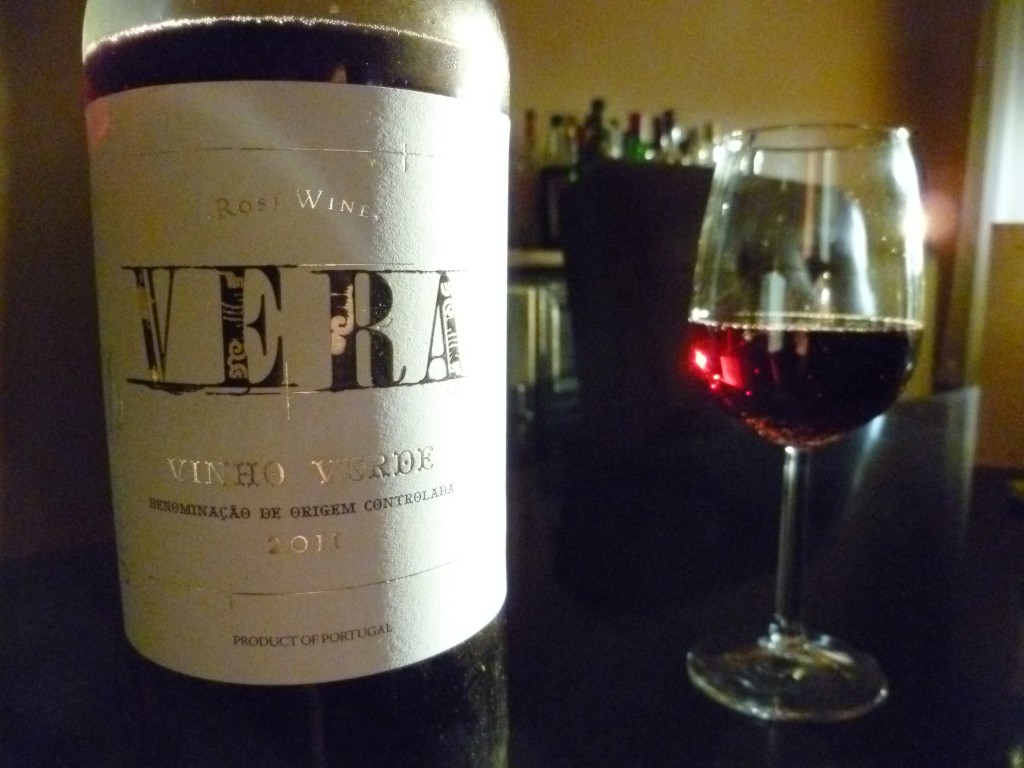Red Green Wine
 I’m not usually a fan of Vinho Verde, which translates as “green wine,” so-called because it’s typically consumed very young. Portugal’s famous low-alcohol, semi-sparkling wine usually tastes too tart for me. It’s been years since I’ve bought a bottle of the stuff. But my dry spell finally came to an end when I came across a bottle of 2011 Vera Vinho Verde at Binny’s. It’s not white (or green) at all — it’s rosé.
I’m not usually a fan of Vinho Verde, which translates as “green wine,” so-called because it’s typically consumed very young. Portugal’s famous low-alcohol, semi-sparkling wine usually tastes too tart for me. It’s been years since I’ve bought a bottle of the stuff. But my dry spell finally came to an end when I came across a bottle of 2011 Vera Vinho Verde at Binny’s. It’s not white (or green) at all — it’s rosé.
A semi-sparkling Portuguese rosé might bring back memories of Mateus, but this wine from the northerly Minho region looks nothing like that mass-market precursor to White Zinfandel. Though called “rosé,” the Vera’s cherry-red color could barely qualify as pink. A red Vinho Verde? And with 11.5% alcohol, no less? I was most intrigued, and I snapped it up.
There’s a reason I had never seen a red Vinho Verde on the shelves before. According to The Oxford Companion to Wine, “Foreign palates struggle with these deep-coloured, rasping reds, and although it is still prized locally, little red Vinho Verde leaves the north of Portugal.” I suspect foreign marketers also struggle with varieties such as Vinhão and Rabo de Anho, which make up 60% and 40% of the Vera, respectively.
Vinhão, at least, is in the Companion. Also known as Sousão, this variety is “widely planted in northern Portugal, where the wine is notably high in acidity as well as colour…” The label on the bottle translates Vinhão as “big wine.”
But the Vera label declares that Rabo de Anho “does not translate at all,” and it may be right. I can find precious little about this variety, the first variety I’ve encountered which doesn’t have an entry in the Companion. According to Wikipedia, it shouldn’t be confused with the white-skinned Rabo de Ovelha, a variety the Companion also notes as white. But the website vinhoverde.pt regards Rabo de Anho and Rabo de Ovelha as synonyms. So I don’t know what the heck is going on.
In any case, calling the rosé Vera Vinho Verde “rasping” is a bit much. It’s dry, but I suspect Vera has sweetened things up just a bit for the foreign palate. In line with its color, the wine has a bright cherry nose, a subtly foamy mouthfeel and tight strawberry fruit on the palate. It is unquestionably tart, however, with limey acids and even a bit of minerality in the finish. I drank the Vera with a chicken stir fry topped with quick-pickled vegetables that my husband made, and with the food, it became rounder and more relaxed.
Because it worked so well with food, I wouldn’t hesitate to recommend this unusual red (or rosé) Vinho Verde. We’re still facing days of 90º and higher in Chicago, and this wine would be ideal for a late-summer picnic or a relaxed evening on the balcony.
SUMMARY
2011 Vera Vinho Verde (rosé): A lovely cherry-red color, this unusual Vinho Verde exudes bright red fruits. Paired with food, its limey acids round out a bit and relax. A good value for the money. Chill well in the refrigerator.
Grade: B
Find It: I bought this bottle at Binny’s for $10.






Hi!
Actually “vinho verde” = green wine is not called that way because it is consumed young… but that is a lie that has been told so many times that somehow became almost true… It is called green wine because it comes from the north of Portugal, a place that is famous for its green landscapes due to the heavy and long winter rains. I can tell because I am from there myself 🙂
I love green wine, not the red but the white only. If you can, try Soalheiro
Thanks
Hi Milena!
Thank you so much for taking the time to read my post and writing a comment. I’ll definitely have to keep my eye out for Soalheiro — I don’t recall trying that one. I had all sorts of lovely Portuguese wines on my last trip to the country in 2017. Such great stuff!
I double-checked on the origin of the name “green wine,” and according to the Vinho Verde PR site (run by Wines of Portugal), http://winesofvinhoverde.com/vinho-verde-101/, the name “green wine” does indeed refer to the fact that the wine is consumed young. I would be surprised if this site propagated a lie about the name, but stranger things have happened.
Thanks again for your comment!
Cheers, Rob